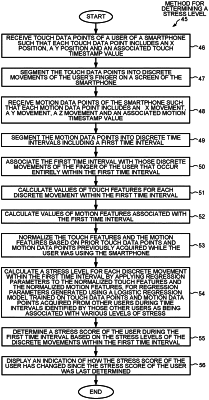| CPC A61B 5/165 (2013.01) [A61B 5/1114 (2013.01); A61B 5/6898 (2013.01); A61B 5/7278 (2013.01); A61B 5/7435 (2013.01); G06F 3/04146 (2019.05); G06F 3/0488 (2013.01); A61B 2090/065 (2016.02); G06F 2203/04105 (2013.01)] | 15 Claims |

|
1. A method comprising:
generating a touch feature value from touch data points of a smartphone, wherein each touch data point includes an X position, a Y position and an associated touch timestamp value, and wherein the touch feature value is an indication of how a finger of a user moves over a screen of the smartphone;
generating a motion feature value from motion data points of the smartphone, wherein each motion data point includes an X movement, a Y movement, a Z movement and an associated motion timestamp value, and wherein the motion feature value is an indication of movement of the smartphone including while the finger of the user moves over the screen of the smartphone;
segmenting the motion data points into non-overlapping time intervals, wherein at least a portion of a first time interval occurs concurrently with the touch data points as the finger of the user moves over the screen of the smartphone, and wherein the touch feature value is generated from the touch data points that fall within the first time interval;
weighting the touch feature value and the motion feature value by corresponding regression parameters, wherein the regression parameters are generated using a logistic regression model trained on touch data points and motion data points identified by other users as being acquired while those other users were experiencing various perceived levels of stress;
generating a stress score based on the weighted touch feature value and the weighted motion feature value; and
indicating to the user whether the stress score is higher or lower than a previously generated stress score.
|